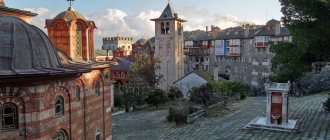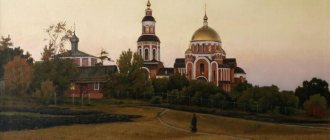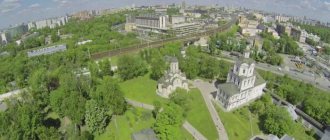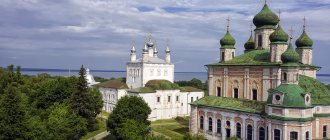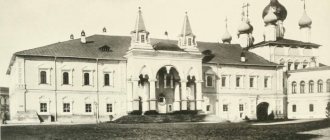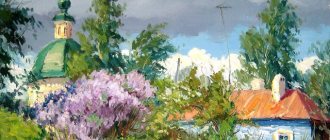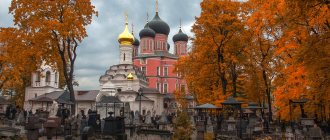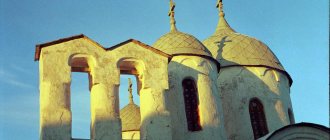Excursions around the outskirts of Kazan | Discount for booking accommodation | Excursions from Kazan to another city | TOURS to Kazan
The Raifa Monastery is located on the territory of the Volga-Kama Nature Reserve, just thirty kilometers from Kazan. The monastery is surrounded by forests.
A trip here is the easiest outing; it can take from 2-3 hours to half a day; a visit to the monastery fits well with other short trips and, in general, can form a program for a day full of impressions (more on this below).
History of the Raifa Monastery
The monastery was founded in 1613. Each pilgrim, entering the monastery courtyard, feels a special atmosphere. The spirit of the place, prayed for centuries, is emphasized by the strict snow-white walls of the monastery.
History of the name
There is a legend according to which hermit monks lived in Raifa in IV. They at one time suffered from the barbarians and were killed by them on the shores of the Red Sea, not far from Mount Sinai and the Raifa desert. It is believed that it was in their memory that a monastery with that name was founded, since this monastery was among the pagans for a long time.
According to other sources, in 1613 a certain hieromonk Filaret settled in a cell near the Sumskoye (Raifa) lake. The monk lived in solitude, but gradually other brothers seeking salvation joined him. This is how the Raifa desert began to form.
The monastery was founded in 1613
Start of construction
In search of a quiet, secluded place, monk Filaret came to Lake Sumy. The Cheremis who lived in those places performed their pagan rituals at the same lake on specific days. They noticed the hermit, and news of him spread over many miles. And from that period the lake began to be called Monastyrsky.
Gradually, other believers began to settle with the hermit monk, and his secluded cell grew into the Orthodox center of that region. One day one of the monks saw a hand in the sky that pointed to a place in the desert. After this, some brothers heard the ringing of bells, which had no source - it came out of nowhere. When Father Filaret learned about this miraculous phenomenon, a chapel was erected at the indicated location.
Shortly before his death, Father Filaret left the life of a hermit and returned to the Transfiguration Monastery, as he wanted to be inveterate according to the canons of the monastery. He was buried there in 1659. And two years later, on the site of his secluded cell, it was decided to build an Orthodox monastery. Around the same period, a copy of the Georgian icon of the Blessed Virgin Mary was delivered there. The original was kept near Kholmogory at that time. Due to the long stay of the monastery among the pagans, it received its name.
Renewal of the monastery
In 1689, a large-scale fire occurred in the area where the monastery was located. Since the monastery buildings were wooden, they were badly damaged. The brethren lost their shelter and were literally left on the ashes. Some brothers left this place and went to other monasteries. But many inhabitants remained to rebuild their damaged home. Then it was decided to build a stone monastery.
At the turn of the 17th-18th centuries, a whole monastery complex with beautiful architecture grew up on this site. Some buildings have survived to this day. The first temple of the monastery was the church consecrated in honor of the fathers killed in Raifa and Sinai. Then they created the St. Sophia Church over the fraternal cells. But it was so small that only seven brothers could fit in it at a time.
The monastery grew quickly; at that time, buildings were erected as a result and there were no long-term construction projects. So, in 1739 there were already 15 churches on the territory of the monastery. Later, the Georgian Cathedral and the gate bell tower were erected. Trinity Cathedral was founded at the beginning of the 20th century. It had incredible acoustics. When the brethren sang in it, the sound carried for many miles around. On the eve of the 1917 revolution, there were about 80 inhabitants in the monastery.
Raifa Monastery in Kazan
Revolutionary intervention
When a bloody revolution spread across Russian soil, many churches and monasteries were closed or destroyed, but initially only on paper. This happened with the Raifa monastery. In 1918 it was officially closed, but the brothers held services in secret. In 1930, all residents were charged with anti-Soviet activities. They were arrested and shot, and the fathers were subsequently canonized. In the temples of the monastery, the Soviet government set up a prison, a colony and repair shops.
Restoration of temples
Since 1991, the revival of churches began. The Raifa monastery was raised from the ruins. Oddly enough, at that time even Muslims provided assistance for the revival of the shrine. President Shaimiev made a donation for five crosses of the Trinity Cathedral.
Trinity Cathedral is the most beautiful in the entire complex of temples. It is very light, perhaps due to the lack of wall paintings. On the other hand, history was thus returned. After all, when the construction was completed at the beginning of the 20th century, the painting was not done due to revolutionary intervention.
Iconostasis in Trinity Cathedral
Over time, its shrine, the Georgian icon of the Mother of God, returned to the monastery from Kazan. Almost at the same time, the first divine service was held in the Georgian Cathedral. On the second floor of the Church of the Holy Fathers, who were killed in Raifa and Sinai, a small chapel was built in honor of those monastic fathers who were shot by the Soviet authorities in the 30s. The whole temple looks like an ark.
The first church, built on the site of the St. Sophia Church, was damaged by a lightning strike. And the St. Sophia Church is the smallest not only in Russia, but throughout Europe. Prayer is performed there only on the day of the celebration of Saints Faith, Hope, Love and their mother Sophia. Subsequently, a fraternal building was added to the temple. The printing house of the Raifa Messenger is also located there.
What is important to know when visiting
On the territory of the monastery there are many ancient temples and churches that attract pilgrims and parishioners. The monastery regularly conducts excursions for excursion groups, where you can get acquainted with the history of the monastery, its shrines and the legends associated with them. And after the excursion, you will be treated to monastery food in the refectory. In the Vodosvyatnaya Bell Tower you can try holy water and even take some water with you.
After a tour of the monastery, you can look into the surroundings of the Rif Monastery, where the arboretum, arboretum and equestrian yard are located. Here you can have a fun walk and book riding lessons and horseback riding tours.
Important! It is worth remembering that excursions to the monastery should be booked in advance, at least 3 days in advance.
There is a Sunday school for children, for whom the monastery organizes outdoor recreation, with swimming in the Volga, picnics, boat rides and sports.
Having visited the monastery, many Orthodox believers are charged with its holy energy and receive the desired healing.
Architectural ensemble and attractions
The first buildings of the monastery were built of wood. They were badly damaged during a fire in 1689 and have not survived to this day. The ensemble that modern pilgrims see was formed during the 17th-18th centuries. It includes:
- Temple in honor of St. fathers in Raifa and Sinai killed. This is the oldest building of the monastery.
- Trinity Cathedral. It is considered the main temple of the monastery.
- Sophia Church. It is the smallest in all of Europe.
- Cathedral of the Georgian Icon of the Blessed Virgin Mary. It contains a list of the miraculous image.
- Gate Church of the Archangel Michael. Its bell tower rises 60 meters and is called the “Raifa Candle” for this reason. This bell tower is considered the most recognizable building of the complex.
The architectural ensemble is harmoniously complemented by a coniferous forest and a lake where the hermit Filaret once settled.
Cathedral in the name of the Georgian Icon of the Mother of God
Cathedral of the Life-Giving Trinity
Bell tower with a gate temple in honor of the Archangel of God Michael
Temple in honor of the Venerable Fathers in Sinai and Raifa who were beaten
Patronal holidays[edit]
Day of the Holy Trinity
— 50th day after Easter
Icon of the Blessed Virgin Mary “Georgian”
- 4 September
Michael, Archangel
— September 19 (memory of the miracle in Khoneh), November 21 (cathedral)
Faith, Hope, Love, holy martyrs
- September 30th
Interesting facts, shrines and miracles
The monastery is rich not only in ancient history, but also in God’s miracles. More information about the life of the monastery can be found on its official website: raifa.ru.
You can fully experience the atmosphere of this place if you go on a pilgrimage with prayer and blessing, and not just on a pleasure excursion.
Author's advice
Holidays and honored dates
Patronal feasts are celebrated in different churches of the monastery on the following days:
- 4 September. Celebration of the main shrine of the monastery - the Georgian icon of the Blessed Virgin Mary.
- January 27. Memory of the venerable fathers who were killed in Sinai and Raifa.
- Day of Pentecost. Altar in Trinity Cathedral.
- September 30th. St. Day Faith, Hope, Love and their mother Sophia are the throne in the small Sophia Church.
- November 21 – Council of the Archangel Michael and the ethereal Heavenly Forces. Celebration in the gate temple.
Georgian icon of the Mother of God
This image has an interesting history. In 1622, Georgia was invaded by Shah Abbas of the Persians. The Persians plundered the wealth of Georgia and, among other things, took away a richly decorated icon of the Most Pure One. Three years later, it was purchased from a Persian merchant by an assistant to a Russian merchant from Yaroslavl. The Russian merchant himself saw this image in a dream and heard instructions to deliver the shrine to the Krasnogorsk monastery.
The Georgian image of the Mother of God is in the monastery
When the merchant saw the icon from his assistant, he remembered the dream and went to the Montenegrin monastery. Its name arose due to the location of the monastery in the mountains, surrounded by impenetrable forest. Subsequently it was called Krasnogorsky.
When the Georgian icon of the Mother of God was brought into the monastery, the first miracle occurred. One of the inhabitants, who for a long time had no hearing or sight, began to see and hear. There were many similar cases of healing.
The entry of the list of the miraculous image into the Raifa monastery was accompanied by numerous processions of the cross. The image was worn throughout the cities. Especially where help was needed, for example, if it had not rained over the city for a long time. The Most Holy Theotokos especially helps through the prayers of the Orthodox before her icon in healing diseases of the eyes and ears, as well as infertility.
Territory of unique toads
As you know, the monastery stands on the shore of a lake. It would be natural if the croaking of frogs was constantly heard in the monastery courtyard, but it is not. There is a legend according to which the first inhabitants of this place suffered greatly from the incessant chorus of toads. They could not pray and rest peacefully because of this noise. They prayed to the Lord asking for help, and the toads no longer croaked.
There are still a lot of frogs on that lake, the place for them to live is wonderful, but they are silent. If you bring a toad there from another territory, it also becomes silent. If you take out a local frog, it begins to croak as soon as it leaves the monastery.
The holy monastery stands on the shore of the lake
Protected area
The nature in the Raifa conservation area is unique. On the shore of the lake you can find oak trees, the trunk of which cannot be grasped with your hands, and an adult man can easily hide in the hollow. The forest, which is considered one of the oldest in Europe, contains three-hundred-year-old pines, as well as firs, lindens and oaks. In the thicket you can find hazel grouse, wood grouse, woodpeckers and voles. Myrtle, wild rosemary, andromeda, cranberries and blueberries grow in the swamps. If you walk along the shore of the lake at dusk, you can see beavers. The arboretum, which is located in the reserve, has more than 400 species of plants.
Where is it located and how to get there
The Bogoroditsky Monastery is located on the territory of the Volga-Kama Nature Reserve, 30 km from Kazan. Address: 422538, Republic of Tatarstan, Zelenodolsk district, pos. Raifa, st. Embankment, 27. To get there, you need to take bus No. 552 or 554 in Kazan at the Northern Station. From Zelenodolsk you can get to the monastery by bus No. 405.
The Raifa monastery is one of the many pearls of Russian Orthodoxy. It has an ancient history and is an example of the steadfastness of the Orthodox people in the revival of their shrines.
If you find an error, please select a piece of text and press Ctrl+Enter.
Pilgrim[edit]
Workers live in the Raifa monastery for free. When settling in, a passport with registration is required. Upon arrival, you should contact the monastery security service, which is located directly at the entrance to the monastery, at the holy gates. Among the things, it is advisable to have a set of shoes and clothes necessary for performing various household duties: cleaning the temple, working in the refectory, in flower beds, etc. If you do not have the necessary shoes and clothes, you can get them from the monastery warehouse, but it is better to have your own, individual ones , which are convenient for you personally. There are enough places for workers to settle, so problems with settlement usually do not arise.
The length of a worker’s stay in the monastery, subject to compliance with the regulations, is unlimited and depends on the person’s personal decision.

